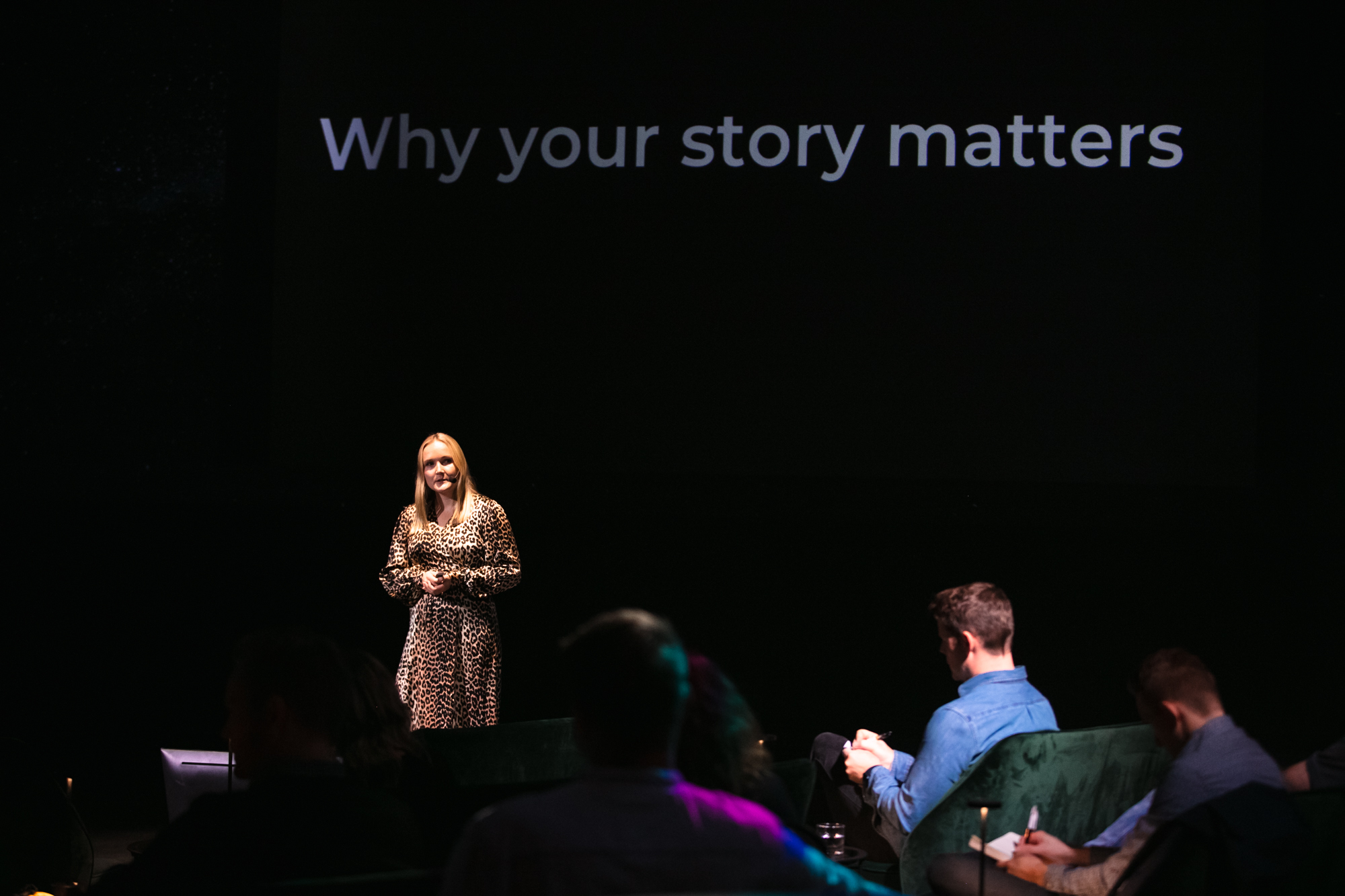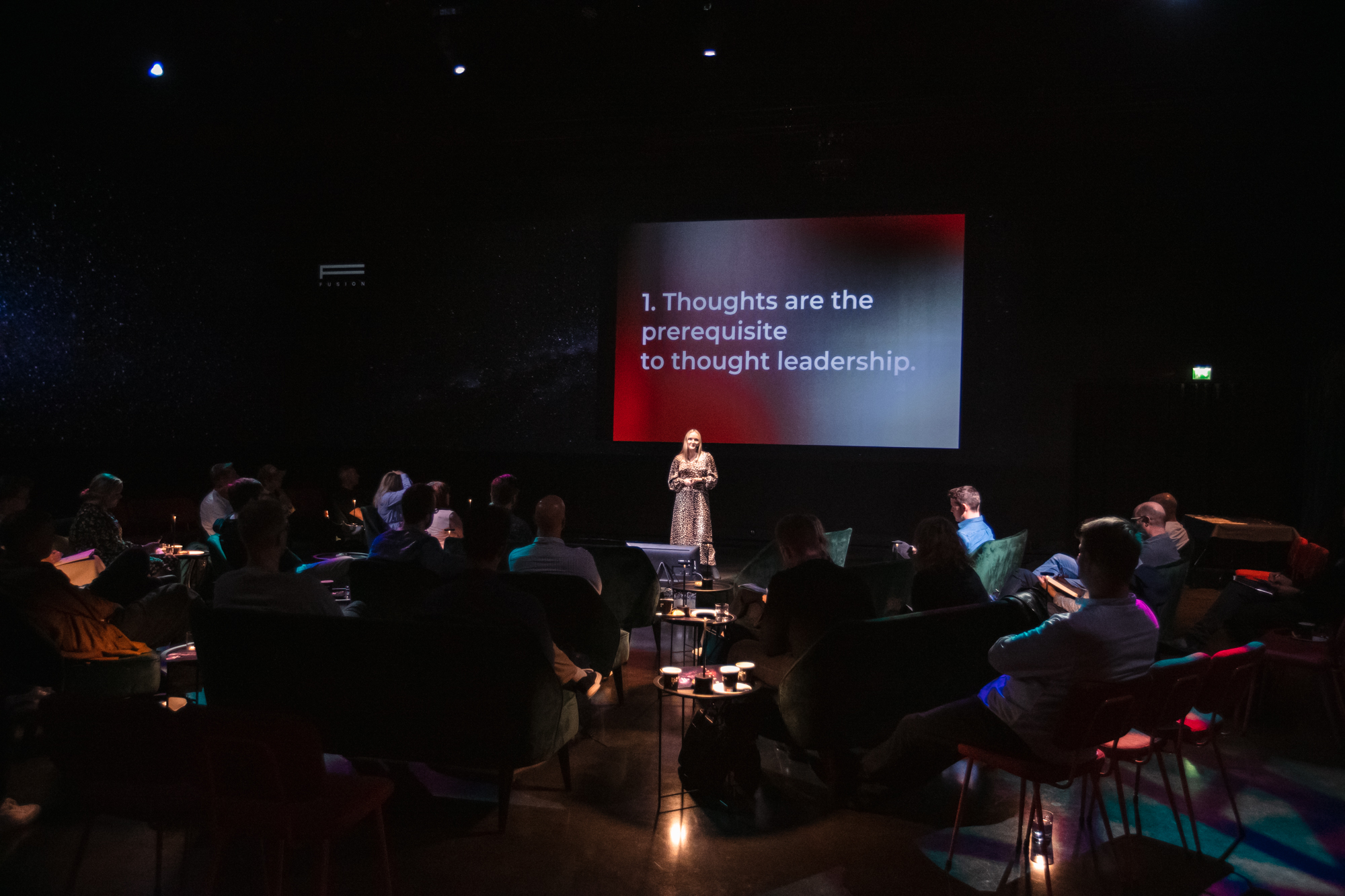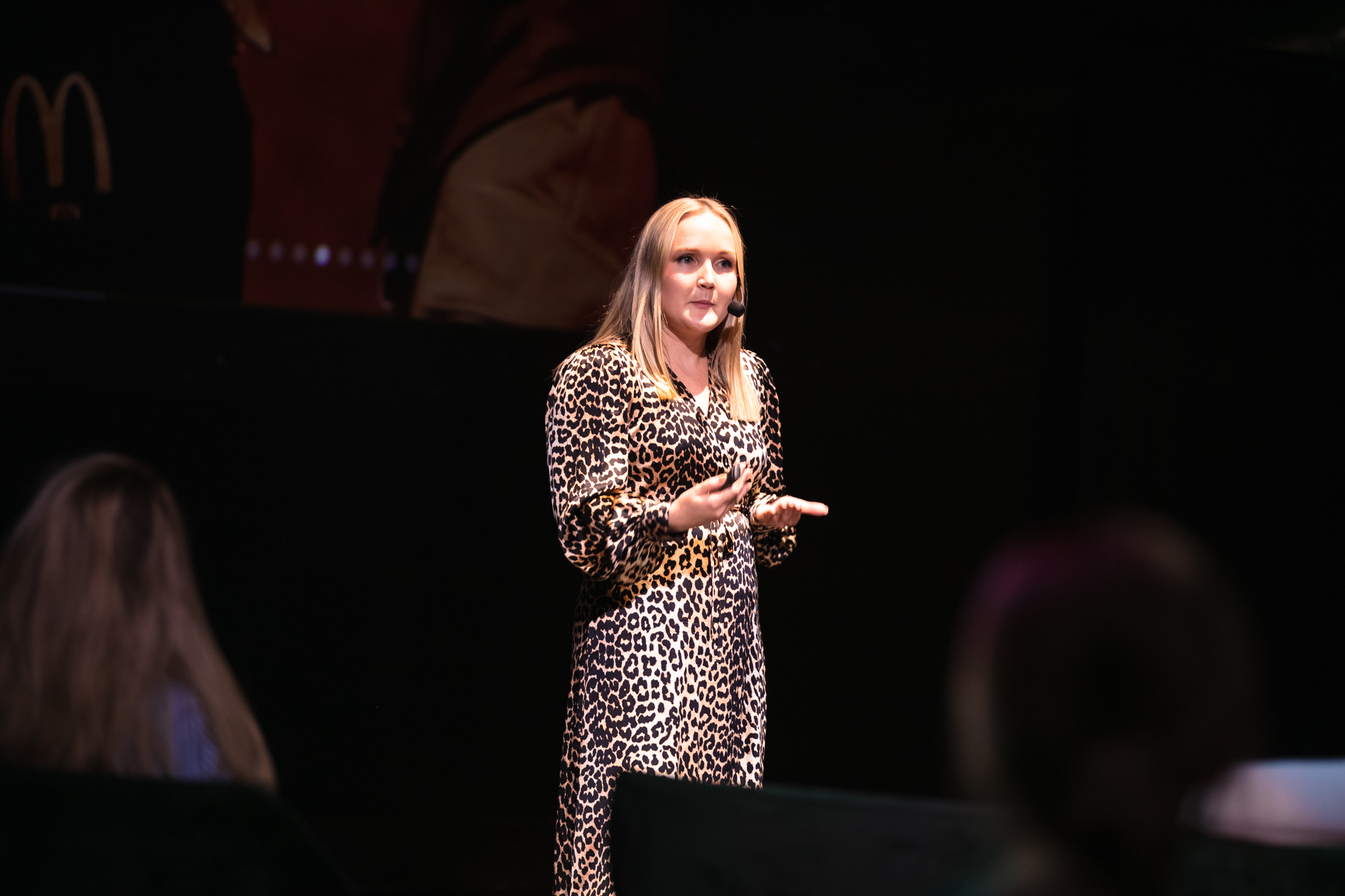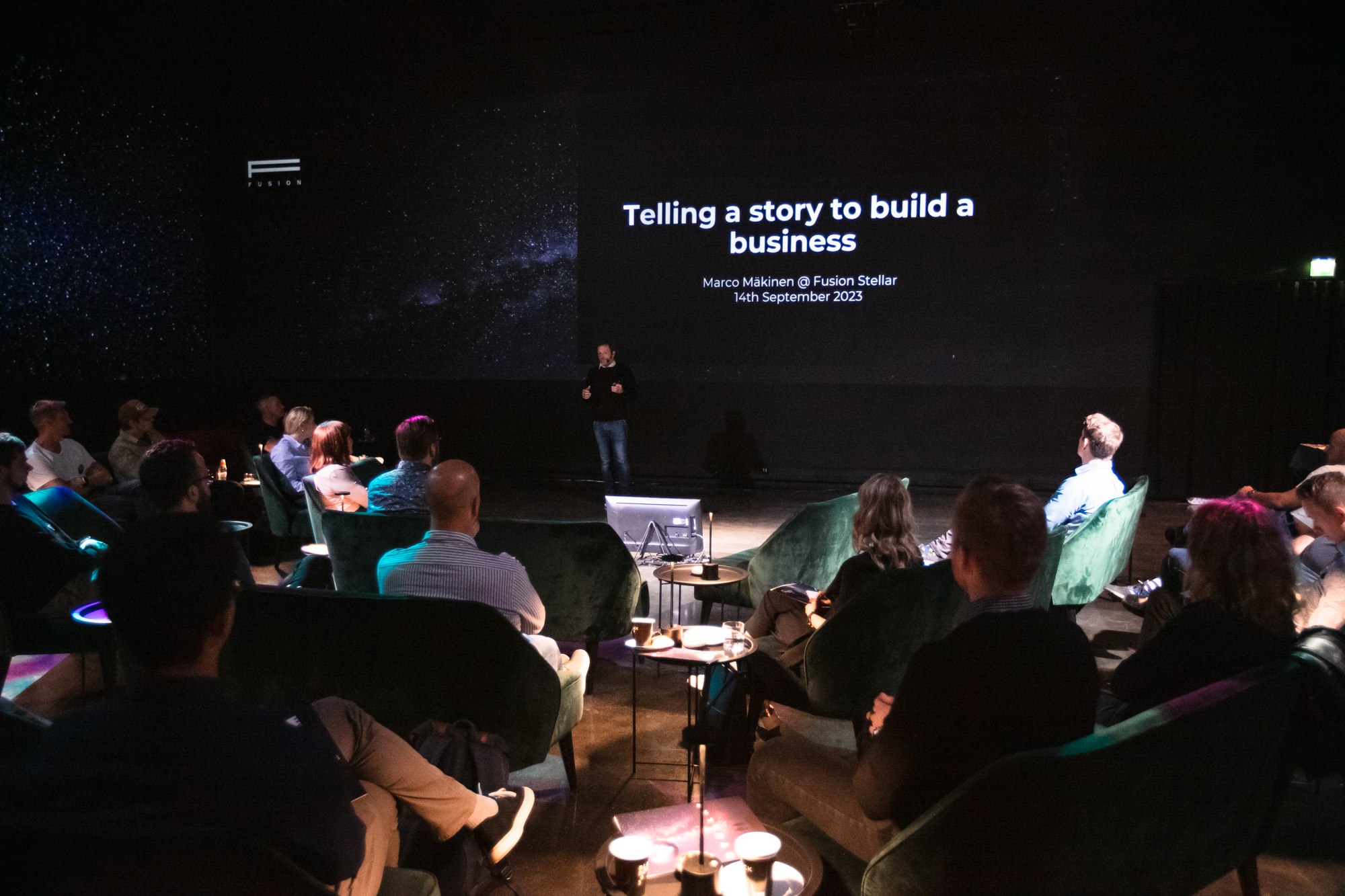From our blog / Article
“It all starts with a story” might sound clishéd, yet it’s often overlooked in building a scalable business. The first Fusion Stellar program session in September 2023 started from where the most successful companies have excelled—crafting an inspiring story that ties together your company mission, vision, and values. The session’s advocates for the art of storytelling in business landscape were Verna Vuoripuro, the Head of Brand & Community at Illusian Family Office, and Marco Mäkinen, the Chief Strategy Officer at TBWA, whose insights we’ll dive into in this article.
Author

We have all witnessed the power of stories, whether through movies, literature, or gossip from our neighbors. Memorable stories stay with us for a lifetime, and this enduring impact is what companies strive to achieve. For instance, the Nike logo instantly recalls the “Just Do It” slogan, essential to Nike’s story of convincing everyone of their athleticism regardless of their background or physique.
Stories’ strength is also scientifically proven: a Stanford study found that information is 22 times more likely to remembered when told as a narrative rather than facts alone. So, to embrace stories’ power in business, Verna Vuoripuro shared the building blocks of a memorable story and Marco Mäkinen continued with how to build one for your company.


Five elements of a story to remember
“A good story never wastes the audience’s time.”
– Verna Vuoripuro
Verna Vuoripuro is a journalist turned into a trusted business leader. She has previously served as the Chief Communications Officer at Reaktor and currently spearheads strategy, customer experience, communications, and community development at Illusian Family Office, established by Supercell co-founder and CEO, Ilkka Paananen.
With Verna’s extraordinary blend of journalistic prowess, tech-savviness, and business understanding, she truly is a one-of-a-kind expert when it comes to storytelling. Her keynote at the first Stellar session revolved around five essential elements of a story to remember:
1.Thoughts are the prerequisite to thought leadership
Achieving thought leadership is an ambition for many, yet realizing it requires meticulously chosen and validated thoughts—to become a thought leader, you must have thoughts. True thought leadership for a company emerges when the collective intelligence of a community amplifies individual insights, strengthening the company’s narrative. Involving team members in the thought leadership work makes them more engaged with pursuing the thought leadership than just dictating the theme from C-level.
2.The most obvious can be the most interesting
Contrary to seeking complexity, usually the most compelling stories lie in simplicity. What seems evident to you may not be apparent to your audience—we have all fallen into the pitfall of being vocal on the fancy stuff just because the simplest things in our everyday work don’t intrigue us as much anymore. Recognizing and articulating the simplest principles of your offering can resonate deeply, making the simplest of ideas captivating. So when choosing the thought and the core of your story, take a step back and think about the essence of your goals and offering.
3.Simplify and repeat. Then do it again. And again.
Already ancient Athenians knew that repetitio mater studiorum, repetition is the mother of all learning. As Verna put it, you’re doing your company storytelling right when you start to get bored of repeating the core message. Especially in the digital era of constant distractions, reinforcing the story is crucial for it to be remembered.
4.Make every single detail count
Every detail contributes to the strength of a story. Ensuring that every aspect of the company’s branding, communications, and visual identity aligns with and reinforces the central narrative is vital for creating a cohesive and impactful message. And don’t forget about internal communications—the storytelling takes the whole organization to make an external impact, thus it should be naturally embedded in the team’s everyday work as well.
5.Dare to give up control
Corporate communications polished to perfection never make a true impact or create memory traces. The human touch builds a more personal and closer relationship with your audience—and is more likely to make it memorable. And what is more human than vulnerability? Verna encourages including strategically chosen vulnerabilities in stories to make them stick. Strategic vulnerability in this context doesn’t mean to overpour your heart and share all the mistakes and setbacks you or your company have had, but to set strict boundaries on what you want to share and, even more importantly, what topics you decide not to disclose.
“Be vulnerable in a strategic way.”
– Verna Vuoripuro


Building the company’s story
Marco Mäkinen is a seasoned brand and growth professional who is also the author of multiple business books, such as Brand in the Boardroom, Grow or Wither and What Happens Tomorrow When Startups Meet Corporations. He works as the Executive Vice President and CSO at TBWA, the disruption company of 307 offices in 97 countries, and an international brand management lecturer at Aalto University. In his keynote, we took Verna’s elements of a memorable story into how to build a business with storytelling.


Storytelling’s three stumbling blocks
“If storytelling is so effective, why are companies so bad at it?”
– Marco Mäkinen
As Verna emphasized, impactful storytelling is consistent and detailed work, but it is probably not as easy as it might first sound. To understand how to create an inspiring story for your company, it’s crucial to understand the common obstacles in succeeding in it. According to Marco, the three major stumbling blocks for companies in storytelling are insecurity, complexity, and anonymity.
Insecurity
A good story’s credibility comes from the confidence in its narrative. It all starts with believing in your and your team’s abilities—firmly. Therefore, the story you choose must be well-grounded in the realities of your skills and vision, yet bold enough to stand out and resonate with your audience. Dare to be audacious, and never stop believing in your story, even in times of insecurity.
Complexity
An outstanding story is not measured by its complexity but rather its simplicity. According to a Siegel+Gale’s research the simpler the brand’s portfolio, the greater the growth rate: since 2009, a stock portfolio of publicly traded brands has outperformed every major index with a return of 1,600%. Developing and maintaining the customer experience is much easier with simpler business models, making it easier to dominate your niche.
Anonymity
Companies are rarely as interesting as people—for example, consider Steve Jobs. Yes, Apple is cool, but would it have become nearly as fascinating without the bold visionary behind the company? People are more intrigued by other people because they can relate to them, while companies, not so much. Step into the spotlight and lead the company with your face to build a compelling and credible story.
As the part of how to present the story is now covered, the second question is how to build it?

Picking up the storyline
Christopher Booker spent over three decades working on his monumental book “The Seven Basic Plots: Why We Tell Stories” and identified seven storylines that cut across all stories told worldwide. Although the book doesn’t approach storytelling from the perspective of company narratives, the same principles apply in the business world, and choosing a basic plot can help you stay consistent with your story.
One of the exercises Marco set in his session was for the Fusion Stellar participants to choose which one of the seven storylines appeals the most to their business or business idea:
- Overcoming the Monster: The protagonist is on a crusade to overcome an antagonist force: an enemy, competitor, or injustice. For example, Salesforce with the slogan: “The End of Software.”
- The Quest: The hero (and their companions) sets out on a journey to find or create something big, impossible, and wonderful, overcoming obstacles until they reach their destination. For example, LinkedIn with a mission to “connect the world’s professionals to make them more productive and successful.”
- Voyage and Return: The protagonist visits an unfamiliar, strange place and returns home with experiences that have had a long-lasting impact on them. For example, Yoga with Adriene: A 30-Day Yoga Journey.
- Rags to Riches: An ordinary protagonist, dismissed by everyone, suddenly steps into the spotlight and is revealed to be someone quite extraordinary. For example, Coursera with their vision statement: “We envision a world where anyone, anywhere can transform their life through learning.”
- Rebirth: A physical or spiritual event leads to miraculous transformation or redemption. For example, Red Bull gives you wings.
- Tragedy: The hero descends into darkness, usually due to their own actions, resulting in their demise. Often used by public health campaigns, insurance companies, or, for example, The Francis Crick Institute with their headline: “From local to global: preparing for the next pandemic.”
- Comedy: A light and humorous narrative with a happy ending, for example, Snickers’ slogan “You’re Not You When You’re Hungry” in its advertising campaigns.
Another useful exercise Marco gave in creating the story and keeping it consistent is to write down a news headline of your company and three medias where the article has been published. Don’t wait for the news headlines to come to you; ideate the news headline yourself first to get there.

Enhance your company's success with an inspiring story
“The story’s real enemy is for it to be boring and confusing.”
– Marco Mäkinen
As we wrap up our insights from the first Fusion Stellar program session, it’s evident that storytelling is not just a form of art but also a tool for building a compelling brand. Storytelling is in vital role in making your company memorable, connecting with people on a deeper level to turn passive audiences into passionate advocates. Hopefully this article gave you a glimpse on how to embrace the power of storytelling to transform the ordinary into the extraordinary.
In the next Fusion Stellar throwback article, we’ll jump to the second session of the program and switch our focus from storytelling to exploring positioning and scalable business models. Stay tuned!


About the Author
Want to know more?
Connect with us.




